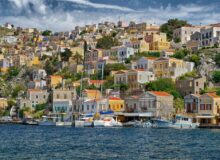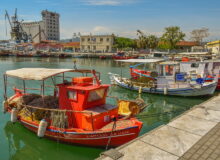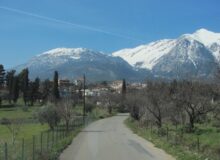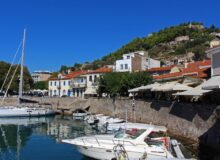The See Greece guide to Santorini in the Cyclades with a brief history and travel information on how to get there by ferry or by air and what to see and do.

Introduction
Santorini is one of the most iconic Greek islands, famous for its breathtaking sunsets, whitewashed villages, and dramatic volcanic landscapes. Part of the Cyclades archipelago in the Aegean Sea, Santorini attracts millions of visitors each year who come to explore its unique beauty, rich history, and vibrant culture.
Whether you’re planning a romantic getaway, a family vacation, or a solo adventure, Santorini offers something for everyone.
Where is Santorini Located?

Santorini (officially known as Thira) is part of the Cyclades, a group of islands in the Aegean Sea, southeast of mainland Greece.
– Geographical Position: 36.4°N latitude, 25.4°E longitude
– Nearest Major Island: Naxos (about 70 km away)
– Distance from Athens: Approximately 230 km (143 miles)
– Size: 76 sq km (29 sq mi), with a population of around 15,000
Santorini is actually a volcanic caldera, formed by one of the largest volcanic eruptions in history. The island’s crescent shape is instantly recognizable, with steep cliffs rising from the sea and picturesque villages perched on the edge.

A Brief History of Santorini
Ancient Times & the Minoan Civilization
Santorini was once part of a larger island called Strongyli (“Round Island”). Around 1600 BCE, a catastrophic volcanic eruption destroyed much of the island, leading to the collapse of the Minoan civilization on nearby Crete.
– Akrotiri: A well-preserved Minoan settlement, often called the “Pompeii of the Aegean,” was buried under volcanic ash. Today, it’s a major archaeological site.
Classical & Byzantine Periods
After the eruption, the island was resettled by the Phoenicians and later the Dorians, who named it Thera after their king.
– Ancient Thera: Ruins from the Hellenistic and Roman periods can still be seen on Mesa Vouno Mountain.
Venetian & Ottoman Rule
In the Middle Ages, the island was ruled by the Venetians, who named it Santorini after Saint Irene. It later came under Ottoman control before becoming part of modern Greece in the 19th century.
Modern Santorini
Today, Santorini is a top tourist destination, famous for its luxury resorts, wineries, and stunning views.

What to See and Do on Santorini
1. Explore the Famous Villages
Santorini’s cliffside villages are its biggest draw.
– Oia – The most famous village, known for its blue-domed churches and sunset views.
– Fira – The island’s capital, filled with shops, restaurants, and nightlife.
– Imerovigli – A quieter alternative with luxury hotels and panoramic views.
– Pyrgos – A traditional village with a medieval castle and charming alleys.

2. Visit the Archaeological Sites
– Akrotiri – A prehistoric city preserved in volcanic ash.
– Ancient Thera – Ruins of temples, theaters, and Roman baths.
3. Relax on Santorini’s Unique Beaches
Unlike typical sandy beaches, Santorini’s shores are volcanic.
– Red Beach – Famous for its red cliffs and crystal-clear waters.
– Kamari & Perissa – Black sand beaches with beach bars and water sports.
– White Beach – Accessible only by boat, with striking white cliffs.

4. Experience Santorini’s Wine Culture
The island’s volcanic soil produces unique wines, especially Assyrtiko.
– Santo Wines – The largest winery with sunset tastings.
– Venetsanos Winery – Stunning caldera views.
– Domaine Sigalas – One of the best producers of Assyrtiko.
5. Take a Boat Tour of the Caldera
– Volcano & Hot Springs Tour – Visit the Nea Kameni volcano and swim in hot springs.
– Sunset Cruise – A romantic way to see Oia’s sunset from the water.
6. Hike from Fira to Oia
A 10 km (6-mile) trail along the caldera edge offers breathtaking views.

7. Watch the Sunset in Oia
The most famous sunset spot in Greece—arrive early to secure a good viewing spot!
8. Visit the Museums
– Museum of Prehistoric Thera (Fira) – Artifacts from Akrotiri.
– Maritime Museum (Oia) – Exhibits on Santorini’s seafaring history.
9. Try Santorini’s Local Cuisine
Must-try dishes:
– Fava (yellow split pea puree)
– Tomato keftedes (fried tomato balls)
– Fresh seafood
– Santorini cherry tomatoes

10. Take a Day Trip to Nearby Islands
– Thirassia – A quiet, traditional island.
– Ios – Known for its nightlife.
– Anafi – A hidden gem with pristine beaches.
How to Get to Santorini
By Air
– Santorini (Thira) International Airport (JTR)
– Direct flights from Athens (45 min), Mykonos, Rhodes, and Crete (summer only).
– International flights from major European cities (London, Paris, Rome, etc.) in peak season.
– Airport to Fira: Taxis (€20-30) or buses (€2.20).

By Ferry
Santorini is well-connected by ferry from Athens and other Cycladic islands.
From Athens (Piraeus Port)
– Fast Ferry (4-5 hours): Hellenic Seaways, SeaJets.
– Conventional Ferry (7-8 hours): Blue Star Ferries (more affordable).
From Other Cycladic Islands
– Mykonos (2-3 hours)
– Naxos (1.5-2 hours)
– Paros (2-3 hours)
Ferry Tips
– Book in advance (summer sells out fast).
– Arrive early for boarding.
– Choose a seat on deck for the best views.
Getting Around Santorini
– Rent an ATV or car (best for exploring).
– Local buses (cheap but crowded).
– Taxis (expensive, limited availability).

Final Tips for Visiting Santorini
– Best Time to Visit: May-June & September-October (fewer crowds, pleasant weather).
– Avoid July-August if you dislike crowds.
– Wear comfortable shoes (lots of stairs and cobblestone paths).
– Respect local customs (modest dress at churches).
Conclusion
Santorini is a dream destination with its stunning landscapes, rich history, and world-famous sunsets. Whether you arrive by ferry or plane, you’ll be greeted by breathtaking views and unforgettable experiences.
From exploring ancient ruins to sipping wine by the caldera, Santorini offers a perfect mix of relaxation and adventure. Plan your trip wisely, and you’ll leave with memories to last a lifetime.















